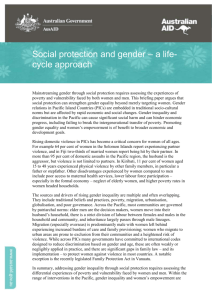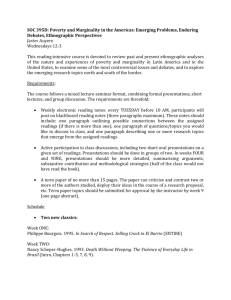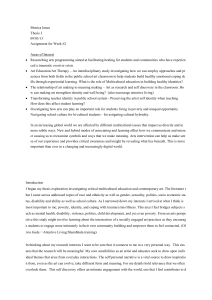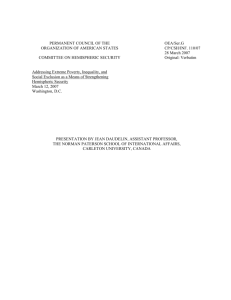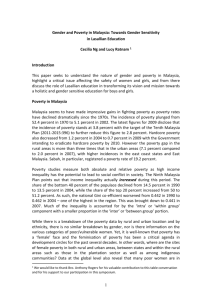2015 Hunger by the Numbers
advertisement
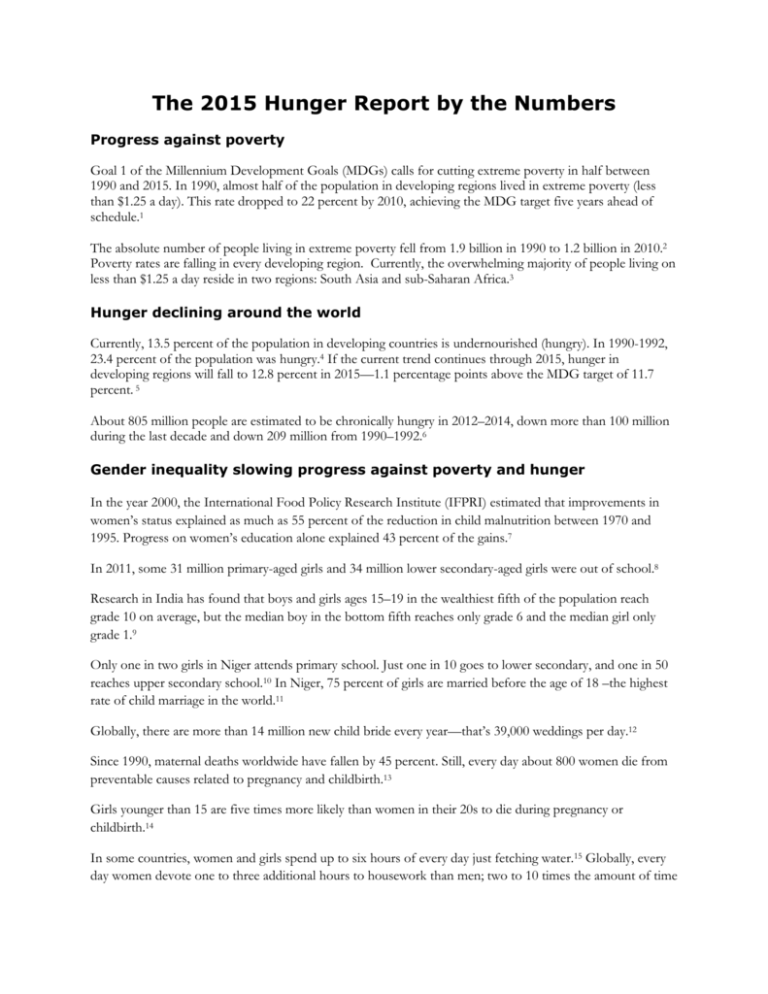
The 2015 Hunger Report by the Numbers Progress against poverty Goal 1 of the Millennium Development Goals (MDGs) calls for cutting extreme poverty in half between 1990 and 2015. In 1990, almost half of the population in developing regions lived in extreme poverty (less than $1.25 a day). This rate dropped to 22 percent by 2010, achieving the MDG target five years ahead of schedule.1 The absolute number of people living in extreme poverty fell from 1.9 billion in 1990 to 1.2 billion in 2010.2 Poverty rates are falling in every developing region. Currently, the overwhelming majority of people living on less than $1.25 a day reside in two regions: South Asia and sub-Saharan Africa.3 Hunger declining around the world Currently, 13.5 percent of the population in developing countries is undernourished (hungry). In 1990-1992, 23.4 percent of the population was hungry.4 If the current trend continues through 2015, hunger in developing regions will fall to 12.8 percent in 2015—1.1 percentage points above the MDG target of 11.7 percent. 5 About 805 million people are estimated to be chronically hungry in 2012–2014, down more than 100 million during the last decade and down 209 million from 1990–1992.6 Gender inequality slowing progress against poverty and hunger In the year 2000, the International Food Policy Research Institute (IFPRI) estimated that improvements in women’s status explained as much as 55 percent of the reduction in child malnutrition between 1970 and 1995. Progress on women’s education alone explained 43 percent of the gains.7 In 2011, some 31 million primary-aged girls and 34 million lower secondary-aged girls were out of school.8 Research in India has found that boys and girls ages 15–19 in the wealthiest fifth of the population reach grade 10 on average, but the median boy in the bottom fifth reaches only grade 6 and the median girl only grade 1.9 Only one in two girls in Niger attends primary school. Just one in 10 goes to lower secondary, and one in 50 reaches upper secondary school.10 In Niger, 75 percent of girls are married before the age of 18 –the highest rate of child marriage in the world.11 Globally, there are more than 14 million new child bride every year—that’s 39,000 weddings per day.12 Since 1990, maternal deaths worldwide have fallen by 45 percent. Still, every day about 800 women die from preventable causes related to pregnancy and childbirth.13 Girls younger than 15 are five times more likely than women in their 20s to die during pregnancy or childbirth.14 In some countries, women and girls spend up to six hours of every day just fetching water.15 Globally, every day women devote one to three additional hours to housework than men; two to 10 times the amount of time in caring for children, elders, and people who are sick; and one to four hours fewer to income-earning activities.16 Globally, women hold an average of 22 percent of seats in national parliaments.17 Between 1990 and 2010, only 16 percent of peace agreements contained at least one reference to women or gender.18 Gender-based violence: a threat to women everywhere Globally, women aged 15-44 are more at risk of rape and domestic violence than cancer, motor accidents, war, or malaria.19 One in three women around the world has experienced violence at the hands of an intimate partner.20 According to the Centers for Disease Control and Prevention, one in four U.S. women have suffered severe physical violence by an intimate partner.21 Research shows that men from homes where the father used violence are more than twice as likely to use violence against their own partners as men who did not experience such violence growing up.22 The feminization of hunger and poverty in the United States In 2013, 31.5 percent of women earned poverty-level wages, significantly higher than the 23.7 percent of men who did.23 The Equal Pay Act was signed into law in 1963. At the time, women were paid 59 cents for every dollar that men were paid.24 The most recent data show that women who work full-time, year-round are paid about 78 cents for every dollar that men in comparable positions are paid.25 Closing the wage gap between men and women would cut the poverty rate among working women and their families by half. The poverty rate for working single mothers would fall from 29 percent to 15 percent.26 Pay equity would make far more progress against poverty than Temporary Assistance for Needy Families (TANF). The total increase in women’s earnings with pay equity, in fact, is more than 14 times as much as the federal and state governments spent on TANF in fiscal year 2012.27 High-income workers are four times as likely as low-income workers to have paid sick leave.28 In a poll commissioned for The Shriver Report, 96 percent of working single mothers who were asked what workplace policy would help them most named paid leave to care for themselves or a family member.29 At the start of 2014, women held a total of 18.5 percent of seats in Congress—18.2 percent in the House of Representatives, 20 percent in the Senate. And this is the highest percentage in history.30 United Nations (2014), Millennium Development Goals Report. United Nations (2014), Millennium Development Goals Report. 3 United Nations (2014), Millennium Development Goals Report. 1 2 Food and Agriculture Organization of the United Nations (2014), The State of Food Insecurity in the World. Food and Agriculture Organization of the United Nations (2014), The State of Food Insecurity in the World. 6 Food and Agriculture Organization of the United Nations (2014), The State of Food Insecurity in the World. 7 Lisa C. Smith and Lawrence Haddad (2000), Explaining Child Malnutrition in Developing Countries: A Cross-Country Analysis, International Food Policy Research Institute, p. xii. 8 United Nations Educational, Scientific, and Cultural Organization: UNESCO Institute of Statistics>Gender and Education. 9 The World Bank (2012), Gender Equality and Development, The World Development Report, p. 74. 10 Jim Yong Kim (March 5, 2014, “Remarks by World Bank President Jim Yong Kim at CARE Conference on Gender Equality,” The World Bank. 11 Girls Not Brides: The Global Partnership to End Child Marriage: Child Marriage Around the World. Accessed March 05, 2014. 12 United Nations Population Fund (2012), “Marrying Too Young: End Child Marriage, p. 45. 13 World Health Organization (May 2014), Fact Sheet No. 348: Maternal Mortality. 14 Save the Children (June 2012), Every Woman’s Right: How family planning saves children’s lives. 15 UN Water: Water and Gender. 16 The World Bank (2012), Gender Equality and Development, p. 80. 17 The World Bank (2014), World Development Indicators: Women in Development, Table 1.5. 18 UN Women (October 2012), Women’s Participation in Peace Negotiations: Connections between Presence and Influence, p 16. 19 United Nations (February 2008), Unite to End Violence Against Women, Fact Sheet. 20 World Health Organization (2005), WHO Multi-country Study on Women’s Health and Domestic Violence Against Women: Initial results on prevalence, health outcomes and women’s responses. 21 Michelle C. Black and others (November 2011), The National Intimate Partner and Sexual Violence Survey: 2010 Summary Report, Executive Summary, Centers for Disease Control and Prevention, p. 2. 22 Michael Kaufman and Gary Barker (November 25, 2013), “We must enlist men and boys in the fight to end violence against women,” The Guardian. 23 Josh Bivens, Elise Gould, Lawrence Mishel, and Heidi Shierholz (June 2014), “Raising America’s Pay: Why It’s Our Central Economic Policy Challenge,” Economic Policy Institute. 24 American Association of University Women (March 18, 2013), “50 Years after the Equal Pay Act, Parity Eludes Us.” 25 U.S. Census Bureau (2014), Current Population Survey. 26 Heidi Hartmann, Jeff Hayes, and Jennifer Clark (January 2014), How Equal Pay for Working Women would Reduce Poverty and Grow the American Economy, Institute for Women’s Policy Research. 27 Heidi Hartmann, Jeff Hayes, and Jennifer Clark (January 2014), How Equal Pay for Working Women would Reduce Poverty and Grow the American Economy, Institute for Women’s Policy Research. 28 Lawrence Mishel, Josh Bivens, Elise Gould and Heidi Shierholz (2012), The State of Working America, 12th edition, Economic Policy Institute, share of workers with paid leave, by wage group, 2011. 29 The Shriver Report: A Woman’s Nation Pushes Back from the Brink (2014), p. 104. 30 Center for American Women and Politics (May 2014), “Fact Sheet: Women in the U.S. Congress 2014,” Rutgers University. 4 5



